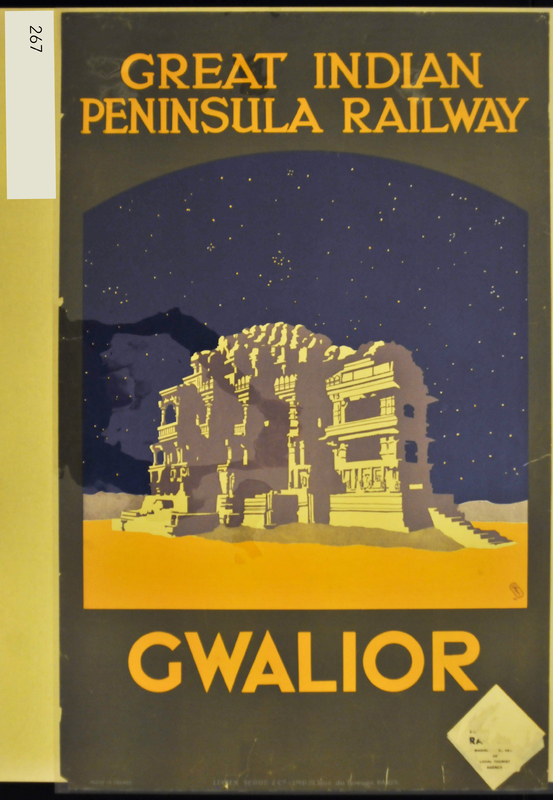Gwalior
Great Indian Peninsula Railway
Item
-
Title
-
Gwalior
Great Indian Peninsula Railway
-
Description
-
Featuring mustard colored text superimposed upon an olive border, this poster adheres to a very basic color palette. A background of deep navy sky, dappled with stars overlooks a mustard desert with what appears to be mountains looming in the distance. A three-quarter view of a large, ancient structure dominates the center of the poster. The structure has distinct shadows and illuminated areas, despite lacking a pictured light source.
Gwalior is a historic city located in the Indian state of Madhya Pradesh (MP), about 322 km South from the Indian capital city of Delhi. Gwalior occupies a strategic location in the Gird region of India; the city and its fortress has been ruled under several historic northern Indian kingdoms. From the Tomars in the 13th century, it was passed on to the Mughals, then to the Marathas (1754) followed by the Scindias in 18th century.
The structure pictured in this poster is that of the Sas-bahu Temple, located to the east of Gwalior Fort. The simple label of "Gwalior" is very misleading as there exists a plethora of similarly structured buildings and historical structures within the city of Gwalior. Built in 1092 by King Mahipala of the Kachchhapaghata (Kachchhwaha) dynasty, this temple is one of the greatest architectural marvels situated by Gwalior Fort. It is 32 metres long and 22 metres at its breadth. This temple has three main entrances from three different directions. In the fourth direction, there is a room which is currently closed. The entire temple is covered with carvings, notably 4 idols of Brahma, Vishnu and Saraswati above its entrance door. As limestone erodes over time, soon portions fell away, spurring conflict as to whether it was a Jain temple or a Hindu temple.
The temple is on the Archaeological Survey of India's list of heritage monuments.
The site is very easily accessible by road, only 22 km from the tourist hot-spot of Udaipur. For those familiar with the area, the site is only 2.7 km from the well frequented Shaivite shrine of Eklingji.
-
Contributor
-
Z. Sherman | zas7474@g.rit.edu
-
Language
-
English
-
Type
-
Poster
-
Identifier
-
Poster 267
http://albert.rit.edu/search~S3/?searchtype=c&searcharg=Poster+267&searchscope=3&sortdropdown=-&SORT=D&extended=0&SUBMIT=Search&searchlimits=&searchorigarg=cPoster+298


